Decentralizing Telecommunications in Latin America
Telecommunications is key to the growth of Latin America's Southern Cone. But to get the most growth, centralized national networks must give way to regional systems that ignore borders.
Policymakers and service pro-viders in the Southern Cone of Latin America will need to implement a new paradigm in telecommunications infrastructure planning in order to optimize regional integration and growth. It will have to be one that moves away from the current system of centralized hierarchical telecommunications networks -- focused on large urban centers -- to a decentralized system of regional networks with a cross-border focus.
This new structure will encourage the expansion of business enterprise in areas outside of the common urban centers of activity in Latin America, such as Buenos Aires, Santiago and São Paulo, allowing companies to take better advantage of the Mercosur economic union by locating portions of their value chain in optimal locations. This paradigm presents a series of opportunities and challenges, for both service providers and policymakers, in terms of their influence on the supply of services and the coordination of national telecommunications policies into a single regional framework.
Unified or Segmented Economic Views
There are two alternative views of what the economies of the Southern Cone of Latin America represent. The first is the aggregate view that sees Mercosur as a set of unified national entities with a population of 205 million, a gross national product close to that of Italy and a per capita G.N.P. of $6,600. From this perspective, the goal of regional growth is built upon the needs of individual nations -- each with its own set of priorities -- that seek development through regional integration.
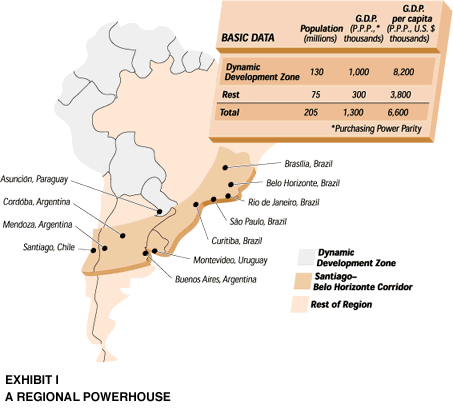
The second view is a segmented one. Rather than looking at country aggregates -- that is, nation-states as a whole -- it focuses on the sections within these nations that hold the most concentrated economic power and innovative industrial strength and that are the centers of most of the production and consumption. (See Exhibit I.) The rapid industrialization of Latin America -- much of it occurring since the 1960's -- and the resulting urbanization have led to a particularly high concentration of economic power in a handful of urban centers.
The segmented view of the Mercosur countries, therefore, considers a series of urban centers that together form a corridor that extends from Santiago, Chile, in the west to Belo Horizonte in eastern Brazil. It covers the Metropolitan Region and Region V in Chile; Mendoza, San Juan, Córdoba, Buenos Aires and the Mesopotamia in Argentina; all of Uruguay, and the southeastern states of Brazil, ending in the triangle of São Paulo, Rio de Janeiro and Belo Horizonte in Minas Gerais. This corridor of urban poles represents about 70 percent of Mercosur's economic power and holds 130 million inhabitants, or more than 60 percent of the Mercosur population. Its G.N.P. is one and a half times that of Spain, and the per capita G.N.P. is $8,200. If the expected growth rates are taken into account, this area will be growing faster (an average of 6 to 7 percent annually) than the overall region (4 to 5 percent).1
Regional integration in Mercosur can therefore be analyzed on either of these two levels: the first considers the national aggregate scale, while the second looks to pan-national integration among the urban centers within the corridor itself. National integration for Mercosur countries, when measured in terms of trade, capital and labor flows, continues to move at a rapid clip. Integration within the corridor, however, is less successful. This shortcoming results from a contradictory process in which countries promote developmental strategies that favor so-called national goals while simultaneously undermining the competitive position of companies that want to move their operations within the corridor, across national borders.
1See Forteza, J., "Competing in Emerging Countries: The Case of Latin America," in Strategy & Business, Second Quarter 1997, Issue 7.
Measuring Regional Integration
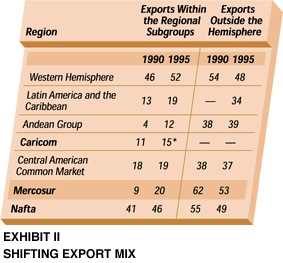
Three principal dimensions of regional integration can be measured: regional trade, capital flows and labor force flows. In terms of regional trade, Mercosur is one of the most dynamic components in the Americas and has shown considerable advance since its creation in 1990. Admittedly, in terms of total percentage of exports, Nafta is more integrated, but the process began prior to the signing of that trade agreement and the flow of exports reflects this long-term integration process. In the case of Mercosur, the proportion of regional exports nearly doubled from 1990 to 1995, a considerable advance for such a limited time period. (See Exhibit II.)
When measuring capital flows in the Mercosur countries, the impact of the Chilean and Brazilian investment in Argentina has to be considered. This increase in capital flows has led Argentina to become one of the big recipients of foreign investment in the region. (See Exhibit III.)
In terms of labor, an increase in the flow of semi-qualified labor from Paraguay to Argentina can be seen, more closely paralleling the needs of the labor market in these areas. This is in addition to the growing exchange of professional labor, particularly in the service sector, moving temporarily from country to country.
So this integration of national aggregates, or countries, is proceeding at a fast pace; this leads to the conclusion that Mercosur has in fact fomented the type of regional integration and growth that its planners intended.

However, there is a second dimension: that of integration within the corridor, which does not represent the sum of national aggregates. It embodies the articulation of sub-components around urban poles,2 each of which has an influence over a periphery that is composed of satellite cities and surrounding rural areas.3 These urban poles tend to relate among themselves along the lines of what communications theory calls communities of interest, unions formed by distinct groups that hold common sets of goals.
2 The concept of urban "corridor" is not new in either demography or regional planning. In some way, it precedes the concept of nation-state. Some might remember "the fertile crescent," which was in biblical times the region that linked the valley in the Asian Mesopotamia with the Nile Valley. In this corridor, the most dynamic elements -- politically, economically, culturally -- were the cities.
3 The concept of an urban pole that drags its periphery, and links itself back to the world economy, is not new. Some of the most noticeable examples include Hong Kong and its surrounding Chinese region. There are cities in this region, such as Shekku, that have grown about 40 percent in the past five years.
Flows of Trade, Labor, Information
The development of these communities of interest is determined by a process driven by trade flows, labor force flows and ultimately information flows -- a process that culminates in the emergence of macro units comprising several urban poles.4 Simply put, a series of urban centers -- in this case those in the Mercosur corridor -- by virtue of their common interest in increased trade and the free flow of labor and information, develops a unified set of interests that supersedes national ties. These developmental interests link the urban centers in such a way that interurban ties can become stronger than the national framework.
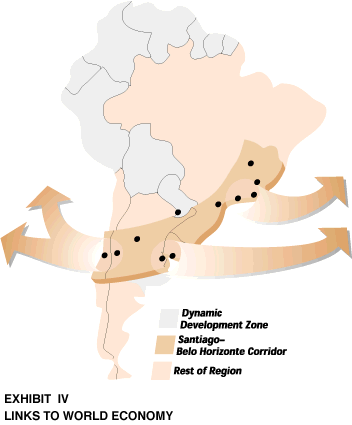
Examples of communities of interest with cross-national ties in the Southern Cone of Latin America are plentiful. These include the links between the urban centers in the Argentine Mesopotamia and the southern states of Brazil; the megalopolis linking Buenos Aires to Montevideo, and the emerging linkage between the Metropolitan Region in Chile and Mendoza, on the Argentine side.
These urban poles play a large role in national development, since they serve as the region's link to the world economy. Not all urban poles, however, are equally important. On the first tier are the national cities. These are the focal point of national development and urbanization and they serve as the country's primary link to the world economy. Within Mercosur, these are São Paulo, Buenos Aires/Montevideo and Santiago. (See Exhibit IV.) These cities have been the engines of national growth in Brazil, Argentina and Chile, and they act as the traditional focus of growth, from both a business and a public-policy perspective.
On the second tier, we identify the regional cities that concentrate sub-units of development and link back to national centers. These include Rosario in Argentina, Curitiba in Brazil and Concepción in Chile. These regional cities are new poles for growth and are often attractive to new and developing companies that want to invest in the region. They are well positioned through their ties to national centers, but to a certain extent offer greater potential to businesses than their over-urbanized larger cousins.
What is most important, however, is that the links between these first- and second-tier cities could potentially cross national boundaries. For example, Mendoza in Argentina and Santiago in Chile have a greater geographic proximity than do Mendoza and Buenos Aires, and a government policy that encouraged the flow of goods and information between these two cities would be mutually advantageous. The future role of business and governments, therefore, will be to recognize these potential links and to make the investments necessary to strengthen them, despite the fact that the ties cross a national border.
4 See Deutsch, Karl, "Nationalism and Social Communication."
Pools of Mutual Interest
In order to best understand Mercosur and its future development, therefore, it is necessary to understand the dynamic of the relation between the urban centers in the corridor and the pools of mutual interest that these relations create. These centers currently serve as engines of growth for the region, but strengthening the links both within and among them is a crucial ingredient for furthering this growth. As a result, therefore, businesses expecting to expand in the region -- by locating some of their operations at or near these urban centers -- and policymakers concerned with the growth of their countries and the region as a whole must move to strengthen the ties between these urban centers so that businesses can take advantage of their geographic positioning. This understanding derives from a rejection of the conventional analysis of Mercosur within a national frame of reference in favor of an understanding of the concept of a corridor structured around a series of urban poles.
Telecommunications: Double Impact
Booz-Allen & Hamilton's experience over the last four to five years of working with users of telecommunications technology and service providers, shows how communications technology has a double impact on regional integration. It acts as a stimulus of regional trade and can influence the recomposition of the value chain of industries operating in the region.
Stimulates Regional Trade
One of the most obvious factors encouraging the growth of regional trade is the decrease of transportation and communications costs. The decrease in these costs has allowed companies to broaden their geographic horizons and to reasonably consider a cross-border structure for different elements of the value chain. Industrialized countries' benchmarks indicate that intra- and inter-corporate telecommunications expenditures for a given company average about 4 percent of total operating costs.5 An extended enterprise that can achieve this level of telecommunications expenses while deploying cross-border business units will tend to adopt this structure if it leads to other competitive advantages (such as benefits derived from improved factor pricing).
To better understand the role of telecommunications in regional growth, and not just country-specific growth, one can consider the following theory: economists have postulated that the magnitude of trade between two countries is proportional to the relative size of their economies and is indirectly linked to the distance between them. Logically, then, neighboring countries will tend to increase their bilateral trade, a well-documented result in the 20th century. One of the principal explanations for this result is the relatively low cost of trade between bordering countries, presuming that restrictive trade tariffs are not in place. One corollary of this theory is that improvements in the links between neighboring countries -- whether in transportation or communications -- will likely have a positive impact on trade. We can therefore understand how a significant decrease in transportation or communications costs decreases the barriers to the flow of goods, information and ideas, and should serve to facilitate international trade.
5 Obviously, this percentage varies by industrial sector, driven by each sector's "information intensity."
Growth Depends on Costs
Therefore, the greater the investment in telecommunications infrastructure, and the lower the costs for companies to gain access to this infrastructure, the more growth there will be in regional trade. If companies can keep telecommunications costs at about 4 percent of total operating expenses, exporting companies can establish more communications links with neighboring countries in a cost-effective manner. As the cost of communication decreases, therefore, the exchange of information that is necessary for regional development increases.
Recomposing the Value Chain
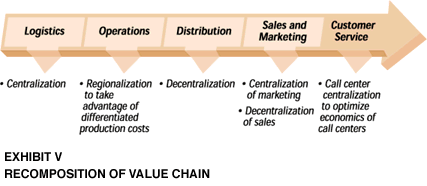
The second way telecommunications influences regional integration has to do with its influence on the geographic recomposition of the value chain. (See Exhibit V.) As in the North American Free Trade Agreement and the European Union, companies within the economies of the Southern Cone are beginning to localize portions of the value chain in those places where they can enjoy a competitive advantage, defined in terms of costs, access to skills or market coverage. Similarly, companies will centralize those functions that are scale sensitive.
As a result, multinational companies are migrating their structure from being the sum of multidomestic units to an integrated or regional multinational. In the process of recomposing the value chain, however, the problems of coordination, planning and monitoring emerge as critical. Communications technology's role in this instance is to act as an enabler, and if it does not, the necessary recomposition will not work. Without the necessary technological improvements, companies that undergo this structural migration will face the following problems: they will be unable to take advantage of just-in-time production processes, they will suffer from erratic distribution channels, they will have a more limited market coverage and they will experience cost increases.
Networks Fail to Meet Needs of Marketplace
This analysis of the structure of relationships within the economies of the Southern Cone leads to an important conclusion: that the telecommunications systems in the Southern Cone of Latin America are dysfunctional with respect to market needs.
Historically, the configuration of telecommunications networks has been driven more by the need to consolidate the nation-state than to support the needs of firms operating along the "corridor."6 The development of telecommunications infrastructure in Latin America -- customarily by monopolistic, state-owned enterprises under nationalistic regimes -- has followed the needs of the nation-state and its interest in concentrating and controlling the flow of information within its borders. This has resulted in the creation of a telecommunications network architecture that meets the needs of an era that has since passed.
For example, the demand for communications within Argentina previously focused on the need to communicate with Buenos Aires. Most traffic flowed within Buenos Aires, and from the provinces to Buenos Aires or vice versa. What resulted, therefore, was the concentration of the most advanced telecommunications services in Buenos Aires at the expense of the interior, and the development of a network architecture focused on establishing communications from all points in Argentina to the capital.
The development of Mercosur, however, and of the cross-national ties among the growing urban centers has led to a new business environment in which flows of information both among cities and internationally would be optimized by a new transmission structure. In order to fully develop the existing cross-border ties between urban centers in the Southern Cone -- and, in the long term, to spur the development of the region as a whole -- nations must facilitate the flow of information among these urban centers, from the perspectives of both capacity and cost. Low-cost communications among these urban centers must be an option, and top-quality services -- including broadband voice and data -- must be made available. This process will certainly be facilitated by the full deregulation of the telecommunications sector, but it also requires an understanding on the part of the relevant actors of the new market demands.
6 An analogous example is that of France's highway network. In the late 17th century, Louis XIV built a series of roads to aid in national defense and to help preserve France as a sovereign nation. Similarly, the United States road system is principally east-west and not north-south because of early settlers' fears of a Canadian invasion.
Hub-And-Spoke Design
The current telecommunications network architecture is a "hub-and-spoke" design, with the hubs focusing on first-tier urban centers. As a result, international communications have a single point of exit from a country -- Buenos Aires for Argentina and Santiago for Chile -- that undermines cost optimization from a company perspective.
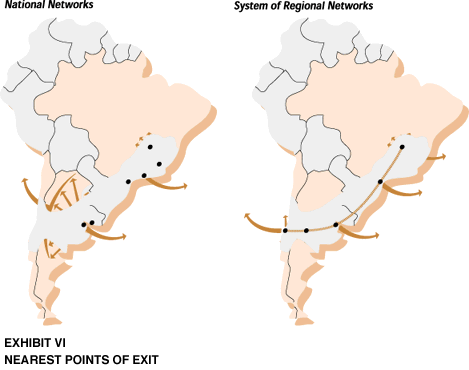
By migrating from a system of centralized hierarchical networks to one of decentralized cross-border focus, companies could pick the nearest point of exit for international voice and data traffic. (See Exhibit VI.) For example, an Argentine company in Mendoza would be best served by strong communications links directly to Santiago -- links that would help the company in terms of both service availability and decreased cost. By adopting the view of Mercosur as a series of urban poles, therefore, telecommunications operators and national governments would act to facilitate the flow of information through these urban poles and, as a result, to promote regional development.
A second inhibitor to appropriate communications is the current tariff structure, a partial consequence of the monopolistic telecommunications market structure in countries such as Brazil and Argentina. Customarily, monopolistic, state-held companies heavily subsidized local call rates with increased domestic long-distance and international tariffs. Although a re-balancing process has begun, it will only be complete once the telecommunications sectors across the Southern Cone have been fully deregulated. This deregulation is still at different stages across the region. (See Exhibit VII.) Increased deregulation and a further tariff rebalancing, which would lessen the existing tariff distortion, are expected.
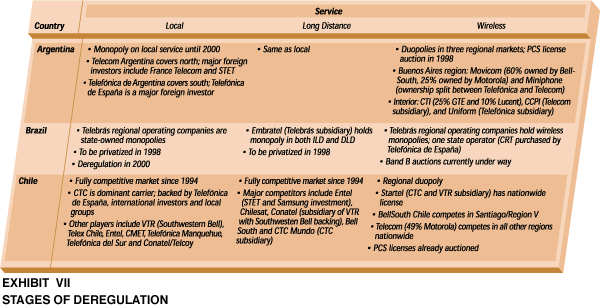
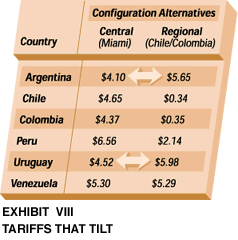
This tariff structure has a significant impact on regional integration. A recent study conducted by Booz-Allen, which focused on the optimal location for a call center for a transnational communications company, led to the result illustrated in Exhibit VIII. This shows how the existing tariff structure for international voice traffic is such that a company that wants to migrate to a disaggregated value-chain structure might decide not to locate a call center in Latin America in favor of one centrally located in the United States, a decision made purely from a cost perspective. For an Argentine customer, it is cheaper to call a Miami customer-service center than one located in Chile.7
This is just one example of the ways in which the existing rate structure can adversely affect regional development because it discourages companies from setting up operations within the region.
7 Recent unilateral moves by the Federal Communications Commission will further accentuate this differential.
Limited Broadband Services
Another aspect of dysfunctionality has to do with deployment of sophisticated telecommunications technology, or the improvement of service quality levels. An important result of the focus on single-city development -- Buenos Aires, Santiago, São Paulo -- is that telecommunications services are not equally available within the borders of a given country. Booz-Allen recently completed a study for a United States government body interested in understanding the impact of telecommunications availability on state development. It found that one of the main drivers of location for information-intensive companies is service availability, with current needs focusing on broadband voice and data capabilities. The limited availability of broadband services outside of major urban centers in the Southern Cone region, therefore, may drive companies that want to locate in the interior -- where labor costs are lower-- either back toward urban centers or out of the region entirely.
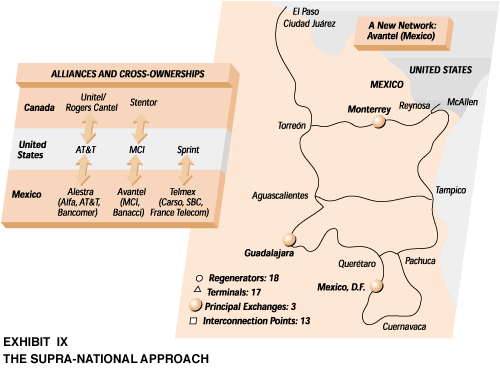
Potential solutions are on the horizon, and Nafta serves as a relevant example. In Mexico, the notion of national networks is giving way to supra-national systems. (See Exhibit IX.) Co-ownership of telecommunications companies certainly helps in this regard, because it brings an international perspective focused more on the ideal network architecture than on traditional conceptions of necessary "nodes" of communications. Regardless of the particular ownership structure of the service providers, the key ingredient for the development of a supra-national system is an understanding of the "hidden" demand for telecommunications services in non-traditional locations.
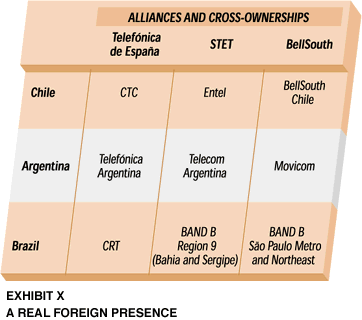
This distributed architecture can be realized in the Southern Cone region, given the proper initiative. Co-ownership is there; foreign participation in Chile, Argentina and Brazil is becoming a reality. (See Exhibit X.) Integration, however, is lagging, although signs exist that the internationally owned operators will move toward the type of integration necessary to support the cross-border ties that are developing in the region.8
The primary challenge, in the end, is not one faced solely by the operators. Governments will also play important roles in this process, potentially through the implementation of common tariffs and coordinated deregulatory frameworks. What is necessary is proactive policymaking at the Mercosur level, not nationally focused policy that will undermine both national and regional growth. The governments' role in the regulatory arena will have a significant impact on the operators' ability to coordinate plans, to build alliances, even to have a common front to negotiate settlement rates with United States carriers. This setting of regional goals may at first be seen to conflict with national priorities. But the implementation of this type of policy will foment the trade flows and investment necessary for continued region-wide growth.
8 See for example, Telefónica's Red Panamericana, cellular companies' cross-national roaming agreements and SkyTel's international paging service. ![]()
Reprint No. 97405
| Authors
Raul L. Katz, katz_raul@bah.com Raul L. Katz is a vice president with Booz Allen Hamilton's New York office. He had 18 years of experience specializing in business strategy, consumer and industrial marketing, and the management of international telecommunications companies. Alexander Dichter, Alexander Dichter is a consultant with Booz-Allen in the communications, computing and electronics group and is based in New York. He has consulted in the telecommunications industry, specializing in strategy, market segmentations and forecasting in the cellular and satellite industries. Mr. Dichter holds a B.A. from Harvard University in political science and Latin American studies and has studied at the Universidad Internacional Menéndez y Palayo and the Universidad Complutense de Madrid. |

